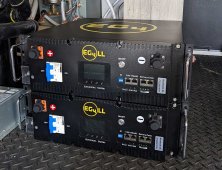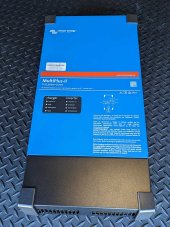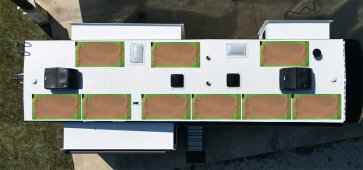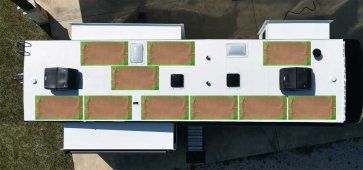You are using an out of date browser. It may not display this or other websites correctly.
You should upgrade or use an alternative browser.
You should upgrade or use an alternative browser.
Can you offer advice on an expandable RV setup?
- Thread starter AllByteNoBark
- Start date
ok..thank you, I guess that makes the most sense, that if there is a problem, you want the fuse to "take the hit" and not the switchThe simple answer is that it's not right in that diagram. The cable from the battery to the switch is not protected. If any cable in the system is going to see a lot of current, it's that one.
Check out this diagram from Victron.
@HRTKD one more follow up, in the link you just posted from Victron, the inverter has a mega fuse also after the switch, but in the diagram for this post there is only the Class T before the fuse. Is the second fuse required?
Most of us are using over current protection on both sides. I have a Class T fuse between the battery and the switch and MEGA fuses between the common bus bar and the Multiplus.
My two batteries are rated for 120 amps, each based on what the BMS is capable of. So a total of 240 amps. My Class T fuse is only 225 amps. It's a bit undersized given what the BMS can do. However, I don't have enough loads to draw even 200 amps, which means there is enough headroom. I should be using a larger Class T fuse. If it ever blows I'll bump up to a larger one.
Thank you, I'm in the middle of installing a 2000W inverter, 2 x 105 Ah battery and a transfer switch in a small travel trailer. I have a 250 amp Class T. This all becomes confusing as there are so many set ups I see while trying to follow these threads. Sorry to hijack this thread and thank you for the help.Most of us are using over current protection on both sides. I have a Class T fuse between the battery and the switch and MEGA fuses between the common bus bar and the Multiplus.
My two batteries are rated for 120 amps, each based on what the BMS is capable of. So a total of 240 amps. My Class T fuse is only 225 amps. It's a bit undersized given what the BMS can do. However, I don't have enough loads to draw even 200 amps, which means there is enough headroom. I should be using a larger Class T fuse. If it ever blows I'll bump up to a larger one.
AllByteNoBark
New Member
Ok, another question. The T fuse recommended was at this link (https://www.amazon.com/gp/product/B00153CXKQ) but is not available, did some searching and it seems sold out everywhere. Saw some info that not all fuses are created equal. Any recommendations for a replacement for that fuse?
Zwy
Emperor Of Solar
If you turn the switch off when it is after the fuse, there wouldn't be a load anyway. Keep fuses as close to power source as you can.@Zwy tks..but why? What makes it prefered?
It sort of makes sense to me to the switch before. If you want to turn power off to fuse to replace it..you have to disconnect the battery.
Ok, another question. The T fuse recommended was at this link (https://www.amazon.com/gp/product/B00153CXKQ) but is not available, did some searching and it seems sold out everywhere. Saw some info that not all fuses are created equal. Any recommendations for a replacement for that fuse?
and
Blue Sea is quality equipment.
AllByteNoBark
New Member
Thanks! Just what I was needing.
12VoltInstalls
life passes by too quickly to not live in freedom
Hmm. I believe you meant, “light duty A/C power in the RV. Can't run AC or electric heat.
AC is electricitylight duty AC power in the RV. Can't run A/C or electric heat
A/C is air conditioning
RoadTurtle
Solar Enthusiast
- Joined
- Mar 30, 2022
- Messages
- 368
I'm so easily confusedHmm. I believe you meant, “
AC is electricity
A/C is air conditioning
Alternating Current is two words
Air Conditioning is two words.
So is AC correct or is A/C correct? LOL
I'm so easily confusedI've actually seen it written both ways.
Alternating Current is two words
Air Conditioning is two words.
So is AC correct or is A/C correct? LOL
I usually just spell it all the way out as air conditioning, so as to avoid any confusion.
Pappion
Retired Engineer Tech
- Joined
- Nov 26, 2020
- Messages
- 559
That wiring might be the typical 10 gauge solar cable. Should be fine for 10 Amp. Some large panels have 10A output, 5.5A - 8A for others, double for parallel. Think Power Loss W= Current * Current * Ohms. 25ft run of 10gauge, is 50ft round trip, is 0.05 ohms. So the loss at 10A would be 5W.It is supposedly "solar ready" which kind of looks like a joke to me as far as wiring from the roof, light gauge and 20 amp fuse on it.
Thanks in advance!
12VoltInstalls
life passes by too quickly to not live in freedom
It’s 120VAC not 120VA/CSo is AC correct or is A/C correct? LOL
AC is sortofa acronym.
A technical colloquialism.
A/C is the accepted nomenclature for air conditioning.
Porsche is said two ways.actually seen it written both ways.
Jaguar is said two or three ways.
Haverhill is said mostly two ways.
Barre is said two ways.
Ariana is said several ways.
Is paraffin wax? Or kerosene?
Of course these days A/C could be identifying as electricity. That’s a bit shocking, current capacity aside.
Watt you do could be amping up a controversy. Ohm I gawd I better not open that circuit. I’ve hertz that can short circuit things. Need to stay grounded.
Snicker, snicker.

RoadTurtle
Solar Enthusiast
- Joined
- Mar 30, 2022
- Messages
- 368
awesome! Thank you for the smile this morningIt’s 120VAC not 120VA/C
AC is sortofa acronym.
A technical colloquialism.
A/C is the accepted nomenclature for air conditioning.
Porsche is said two ways.
Jaguar is said two or three ways.
Haverhill is said mostly two ways.
Barre is said two ways.
Ariana is said several ways.
Is paraffin wax? Or kerosene?
Of course these days A/C could be identifying as electricity. That’s a bit shocking, current capacity aside.
Watt you do could be amping up a controversy. Ohm I gawd I better not open that circuit. I’ve hertz that can short circuit things. Need to stay grounded.
MisterSandals
Participation Medalist
Not my position but someone has to say it:It’s 120VAC not 120VA/C
It's HVAC not HVA/C
John Frum
Tell me your problems
- Joined
- Nov 30, 2019
- Messages
- 15,230
For air conditioning I like aircon.Not my position but someone has to say it:
It's HVAC not HVA/C
It all falls apart when you add heating and ventilation though.
AllByteNoBark
New Member
Well as usual I went ahead and jumped in the deep end. Ordered 2x EG4-LifePower4 Lithium Battery 12V 400AH on Saturday ands they arrived today. Extremely fast service, pretty impressed. Also it looks like I got an upgraded version of the battery. They have a built in interface and a Bluetooth id listed on each unit.


The only negative so far is I do not find a manual and the online manual does not match what I am seeing. Have sent an email inquiring about a download that is current.
Also got my shunt and various other parts in. Starting to get a bit scary being my first install. Will probably be asking lots more questions.


The only negative so far is I do not find a manual and the online manual does not match what I am seeing. Have sent an email inquiring about a download that is current.
Also got my shunt and various other parts in. Starting to get a bit scary being my first install. Will probably be asking lots more questions.
Pappion
Retired Engineer Tech
- Joined
- Nov 26, 2020
- Messages
- 559
envyWell as usual I went ahead and jumped in the deep end. Ordered 2x EG4-LifePower4 Lithium Battery 12V 400AH on Saturday ands they arrived today. Extremely fast service, pretty impressed. Also it looks like I got an upgraded version of the battery. They have a built in interface and a Bluetooth id listed on each unit.
View attachment 133842
View attachment 133843
The only negative so far is I do not find a manual and the online manual does not match what I am seeing. Have sent an email inquiring about a download that is current.
Also got my shunt and various other parts in. Starting to get a bit scary being my first install. Will probably be asking lots more questions.
AllByteNoBark
New Member
Another piece of the puzzle came today. Also spent a bit of time and worked on layout for panels. Here is the latest piece.

Sucker is kind of heavy.
Used the drone ot get shot of the roof with a sample cardboard panel up there. My drone shot is not perfectly square but close enough for planning. Then copied the sample panel and placed it where I thought they would fit best. (Stole that idea from a Changing Lanes YouTube video.) Used Newpowa panels for the layout but am looking around to see what else is out there. With their 220 10bb panels (30.25" x 57") I would probably go with 8 or 9 of them. The string of 4 on the bottom right of image is a bit tight, so maybe 8. Would look similar to this.

If I used the 200 9bb's which are a bit narrower (27.76" x 55.28"), I could put 9 or 10 panels and still have room to move around.

Any words of wisdom or panel recommendations?

Sucker is kind of heavy.
Used the drone ot get shot of the roof with a sample cardboard panel up there. My drone shot is not perfectly square but close enough for planning. Then copied the sample panel and placed it where I thought they would fit best. (Stole that idea from a Changing Lanes YouTube video.) Used Newpowa panels for the layout but am looking around to see what else is out there. With their 220 10bb panels (30.25" x 57") I would probably go with 8 or 9 of them. The string of 4 on the bottom right of image is a bit tight, so maybe 8. Would look similar to this.

If I used the 200 9bb's which are a bit narrower (27.76" x 55.28"), I could put 9 or 10 panels and still have room to move around.

Any words of wisdom or panel recommendations?
If you use the typical Z brackets to secure the panels to the roof, be aware that the Z brackets add 1" to 1.5" to the "footprint" of the panel. You don't want to get too close to the edge of the roof with the panel brackets.
Unistrut is a popular alternative way to secure the panels. It's my understanding that the brackets inserted into the Unistrut should attach to the long ends of the panels, two per side. In your case, if you laid the Unistrut rails parallel to the trailer length that would work. However, if you do that then should you decide later to use a wider (not longer) panel, the rails would not be in the right position. The "solution" to that is to add another layer of Unistrut perpendicular to the existing Unistrut, which would allow you to accommodate a wider or narrower panel.
I used Z brackets to install my panels. It was only two 320 watt panels, so not a big deal. Next time, I'll probably use Unistrut. The really nice thing about the Unistrut is that you can get it secured into every roof truss. Securing anything into just the roof subsurface (OSB/plywood/etc) isn't good enough. If you have a fiberglass or aluminum roof, adhesive can be good enough (no screws), but I'm not a fan of using just adhesive.
Depending on how you plan to configure the panels (series/parallel), odd numbers of panels don't work well. If you're going to created distinct strings associated with their own solar charge controller, then the number of panels on each string doesn't matter. Attempting to parallel strings with different numbers of series panels is not optimal.
10 panels could be more than 300 lbs of additional weight on the roof, not including mounting hardware and cabling. Something to keep in mind.
Unistrut is a popular alternative way to secure the panels. It's my understanding that the brackets inserted into the Unistrut should attach to the long ends of the panels, two per side. In your case, if you laid the Unistrut rails parallel to the trailer length that would work. However, if you do that then should you decide later to use a wider (not longer) panel, the rails would not be in the right position. The "solution" to that is to add another layer of Unistrut perpendicular to the existing Unistrut, which would allow you to accommodate a wider or narrower panel.
I used Z brackets to install my panels. It was only two 320 watt panels, so not a big deal. Next time, I'll probably use Unistrut. The really nice thing about the Unistrut is that you can get it secured into every roof truss. Securing anything into just the roof subsurface (OSB/plywood/etc) isn't good enough. If you have a fiberglass or aluminum roof, adhesive can be good enough (no screws), but I'm not a fan of using just adhesive.
Depending on how you plan to configure the panels (series/parallel), odd numbers of panels don't work well. If you're going to created distinct strings associated with their own solar charge controller, then the number of panels on each string doesn't matter. Attempting to parallel strings with different numbers of series panels is not optimal.
10 panels could be more than 300 lbs of additional weight on the roof, not including mounting hardware and cabling. Something to keep in mind.
AllByteNoBark
New Member
If you use the typical Z brackets to secure the panels to the roof, be aware that the Z brackets add 1" to 1.5" to the "footprint" of the panel. You don't want to get too close to the edge of the roof with the panel brackets.
Unistrut is a popular alternative way to secure the panels. It's my understanding that the brackets inserted into the Unistrut should attach to the long ends of the panels, two per side. In your case, if you laid the Unistrut rails parallel to the trailer length that would work. However, if you do that then should you decide later to use a wider (not longer) panel, the rails would not be in the right position. The "solution" to that is to add another layer of Unistrut perpendicular to the existing Unistrut, which would allow you to accommodate a wider or narrower panel.
I used Z brackets to install my panels. It was only two 320 watt panels, so not a big deal. Next time, I'll probably use Unistrut. The really nice thing about the Unistrut is that you can get it secured into every roof truss. Securing anything into just the roof subsurface (OSB/plywood/etc) isn't good enough. If you have a fiberglass or aluminum roof, adhesive can be good enough (no screws), but I'm not a fan of using just adhesive.
Depending on how you plan to configure the panels (series/parallel), odd numbers of panels don't work well. If you're going to created distinct strings associated with their own solar charge controller, then the number of panels on each string doesn't matter. Attempting to parallel strings with different numbers of series panels is not optimal.
10 panels could be more than 300 lbs of additional weight on the roof, not including mounting hardware and cabling. Something to keep in mind.
All good points. The width of panels is a bit of a concern, makes me lean toward the 200's. May consider the RICH Solar panels as they are an inch narrower. I do plan on using Unistrut for mounting unless something better shows up. I know you should never say never, but I do not anticipate upgrading to larger panels. Will for sure be screwing to the roof trusses.
Good point on the number of panels also. I am still in the research mode on MPPTs, they seem the most difficult part for me to get a grasp of.
Weight wise I have a max total of 800lbs additional weight as my target. Batteries add 100 of that, then all the other stuff and panels will eat at it pretty quickly. Another reason to consider the RICH panels I guess. I could go over that but then the wife would need to pack less.
Thanks for the response.
Look local for panels. Shipping panels has not been very successful. There are plenty of threads here about broken panels and lousy customer service getting them replaced. This is for just about any vendor. The challenge with picking up panels locally is that they'll all be residential and the larger format. But local sure beats the heck out of incurring shipping costs.
I had planned to install four 200 watt panels on my RV, but when I tried to come up with a plan for placing them there just wasn't room. So I switched to two larger panels. Fewer, larger panels means less install time. I used a CAD program to make sure the dimensions of everything were 100% right.
I had planned to install four 200 watt panels on my RV, but when I tried to come up with a plan for placing them there just wasn't room. So I switched to two larger panels. Fewer, larger panels means less install time. I used a CAD program to make sure the dimensions of everything were 100% right.
RoadTurtle
Solar Enthusiast
- Joined
- Mar 30, 2022
- Messages
- 368
Push the panels all the way to the outer edge. You can see shadows from the aircon units, shadows are devastating to a panels output. With as many panels as you have, I'd look at a rail system. Carefully consider how they are going to be wired and the impact to the system. I don't have nearly as much usable roof space as you do, and divided my panels into three on drivers side and three on pass side and ran parallel connection wires to two SCC
Similar threads
- Replies
- 3
- Views
- 224


